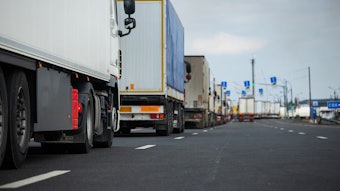
Distribution is often an afterthought when deciding how the plant should operate. But this may create a very real dissonance, significant additional cost, and drive customer service in an unacceptable direction. What approaches can be leveraged to achieve a smooth, cost-effective flow and eliminate the dissonance between production and distribution?
Plants have long focused on developing and adhering to an efficient production schedule, but how much thought goes into an efficient distribution approach?
This review identifies technology to improve cost and customer service for two very different situations:
1. Plant with a warehouse that has space
2. Plant with limited/no storage that has to push the product off the end of the line onto a truck
Plant with a warehouse – ignoring distribution is expensive
There's a significant dissonance between planning and deployment. Simply put, planning systems don't consider capacity constraints such as space at the plant or downstream distribution centers (DCs), the ability to ship, and the availability of cost-effective carriers.
There are consumer-driven fluctuations in demand. For example, most retail shopping is done on the weekends. The resultant ups and downs of demand on the DCs flow back in the form of a deployment signal. And this deployment signal can be all over the place. Unfortunately, it's tough to manage twenty loads today and two tomorrow. This volatility stretches dock capacity and causes the operation to overstaff or underperform. Underperformance has a genuine penalty: the blame when a customer is short-shipped. For example, when a downstream DC gets several loads in a day, it may have the inventory in the yard but can’t get to it in time to meet customer demand.
However, the most easily recognized cost is the cost of procuring lots of trucks on one day and a few on the next. This forces cost and service trade-offs that are in many cases undesirable.
Plant with a warehouse -- smoothing can be achieved
Smoothing requires understanding:
· Customer service--the costs associated with such things as running a customer out of product)
· Transportation costs--needing to hire more trucks at a premium price to meet service goals
· Site throughput capacity—locations must receive at the same time as customer shipments must be dispatched.
· Space constraints in the network
· Priorities of need--when there is a constraint-like space, only the most needed should be deployed.
· Deployment in food and beverage consumer packaged goods (CPG) is typically done in truckloads. So, the priority of what will be on each needs to be considered in aggregate.
Importantly, all this needs to be considered simultaneously. After all, adjusting the volume on any lane or at any point in the network impacts other things in the network.
There is technology to do all this—an optimizing digital twin that does deployment transportation scheduling. Looking forward 30-60 days and using advanced linear programming that combines with an artificial intelligence (AI)-enabled load builder, a large manufacturer has significantly reduced its transportation costs and improved customer service.
The same company, recognizing they had a forecast of how many trucks would be needed on each lane over the following weeks, also saw the opportunity to jump to the head of the queue by being first to secure (tender) trucking capacity. While most companies have already determined what will be on each load, the carrier doesn't need this information –they need the origin, destination, date and type of equipment, and number of trucks. Once the transportation capacity is secured, much closer to the ship date, the contents of each load can be determined. The deployment planning software has much more information about what has shipped in the intervening time, enabling it to better tailor each shipment to maximize customer service at the receiving site.
A plant with very limited storage
Sites with limited or no storage must push products off the end of the production line and into the network. Most do this using a straightforward but expensive approach: shipping to a local “buffer” warehouse that will later deploy to the rest of the network. Multiple handlings and moves add significant costs. The challenge is optimally deploying to the network as items come off the production line. It would be easier if production lines ran with 100% reliability. They don't. Different sites have different priorities and needs. How do you get the right product to the right place and avoid the cost and service issues by repositioning stock?
Shipping off the line to the final destination (without losing payload)
Under conditions of uncertainty, using the best available information, such as updated production schedules, distribution requirements by item and destination, and their needed priority, it is possible to predict when trailers are needed for each destination one, two, or even three days out. In this way, carriers can be informed of the need for vans and the likely time they could be dispatched.
To ensure the product is sent to the location in most need, the first product off the line is assigned there. But what should we ship with this high-priority product to complete the load? The technology uses available dock space to preposition "filler" inventory that maximizes payload.
The optimization is time-phased over multiple days. By looking at what should happen in 2- to 4-hour buckets, it's possible to determine when the product should be put aside into the dock location. This, combined with what is coming off the line, can be loaded directly into the trailer, obviating the need to stage product anything other than the filler stock.
Incrementally, it's possible to create 3-D loading diagrams to show loaders where the product should be positioned. Keep in mind that these are "aspirational" loads, as the product may not arrive in the sequence that it is planned. Replanning may be necessary.
Food and beverage plants can significantly benefit from creating an executable distribution plan. "Good companies plan; great companies execute the plan.” By executing the plan, these companies can significantly reduce their costs, improve order fill, and drive significant value from high–payback technology tools. The dissonance is eliminated.

























